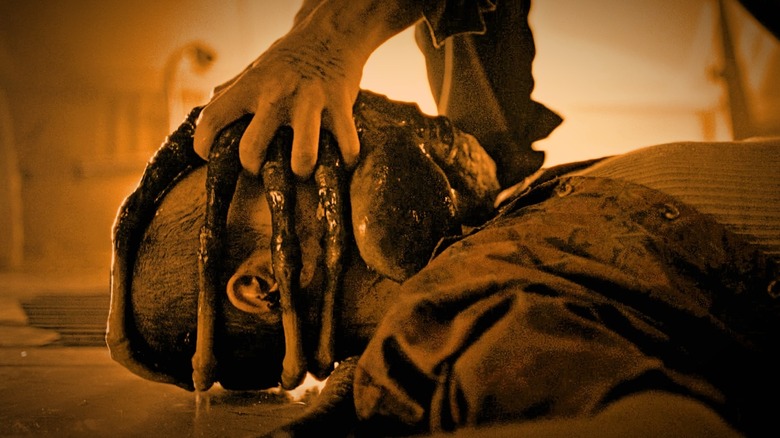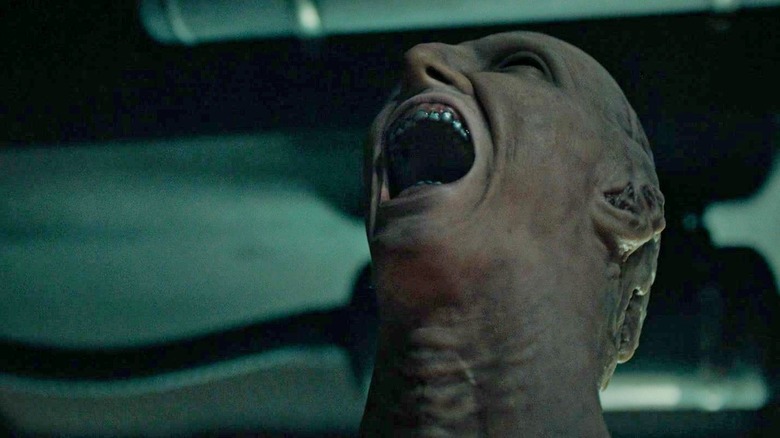Alien: Romulus Used A Certain Seasonal Delicacy To Simulate Chestburster Sounds
Halloween may be over for 2024, but keeping things creepy is a year-round dedication. This past weekend, I was fortunate enough to check out the "Alien: Romulus" activation at the Los Angeles Haunted Hayride during its final weekend of operation thanks to 20th Century Studios and Team Click. It was a life-affirming experience to get up close and personal with a Xenomorph, see a chestburster explode from two feet away and blood over unsuspecting journalists, and most importantly — have the opportunity to sit down with the prolific co-supervising sound editor of "Alien: Romulus," Lee Gilmore, to learn just how the effective sound of the film came to be.
The "Alien" franchise is unique in that the series has always been about dehumanization, and that it combines the sound of early, analog technology with the visceral, squelchy sounds of the human body being ripped apart — an absolute dream come true for someone working in sound design.
In talking with Lee Gilmore, he confessed to the press group that the sound of the Nostromo booting up in "Alien" is what made him fall in love with sound design in the first place, and that many of the most graphic moments in "Romulus" were brought to life using sounds that could be recreated by the average person at home. For instance, the gore sounds were created using a 15-pound bag of leftover meat bits from a local Ralph's Grocery Store butcher. "I have no idea what was in it, you know, because it was like ... nothing looked like a steak [laughs] it was just like, the rejects and all kinds of junk in there," Gilmore said.
The sound team took the bag of meat and purchased lobsters and crabs to take back to Gilmore's shop to get really weird with it. Unfortunately, all of the uncooked meat made his studio smell terrible, and he jokes that it "still stinks." Using the raw materials allows for more realistic sounds, but the key to one of the biggest scares in the entire "Alien" franchise came from a seasonal delicacy — if you need a chestburster to sound fresh, all you need is a pumpkin.
Alien: Romulus proves pumpkins make for gourd scares
The sound of a chestburster is instantly recognizable because it requires the sound of skin tearing, ribcages cracking, organs splitting, and viscera sloshing about as the alien pushes through the front of its host. A pumpkin — with its rind, ribs, fibrous strands, pulp, and seeds — makes for a great double for a human chest cavity. Gilmore ripped apart pumpkins for the chestburster, but he also reused the gourd for the sound of Kay's delivery of The Offspring.
"A lot of times when you're doing gore stuff, it can be just really kind of wet and drippy and I like stuff that really sounds like it came from inside your body," Gilmore tells me during our one-on-one discussion. "During Kay's birth scene, we wanted stuff that almost had an inhaling breathing quality, like it's coming from inside of a womb and it has a cavity feeling — like we record a lot of pumpkins being ripped and stuff because pumpkins have such kind of a cavity vibe to them." They didn't reuse the same pumpkin sounds for both scenes, instead recording entirely different manipulations on the pumpkin to nail the perfect sound. But the food usage doesn't stop there.
"I tried to stay away from your traditional bloody drip stuff and go with pumpkins and different types of foods and muds," Gilmore says. "I'd had refried beans coming out of the can, I recorded that kind of stuff ... it's got that real gross, slow suction sound coming out. That's my jam as far as gore stuff goes." Gilmore's approach worked extremely well, because "Alien: Romulus" had many squirming in their seats over the grotesque symphony of squelching unleashed throughout the film.
It's also what makes the quieter moments so effective because the juxtaposition lulls the audience into the same sense of claustrophobic panic as the characters on screen trying to stay quiet.
The cavernous sounds of the cargo hold in Alien: Romulus
I mentioned to Gilmore that the sound shifting after the birth of the Offspring was also compelling because the character comes to be in a wide, open space on the ship. As it turns out, one of Gilmore's sound designers, Chris Terhune, was in charge of all things Offspring. "[The Offspring] doesn't make a ton of sounds and originally it's one of these things where it was like, less is more," Gilmore says. "We had vocals in for him, but he was a lot more scarier if he was just kind of standing there." The Offspring's reveal comes after an excruciating childbirth sequence, so to counter the painful screams and bodily destruction, the sound takes a hard left into silence.
"The first time he's revealed all the sound drops out and it's great," Gilmore jokes, "You can just hear the whole theater's buttholes clench up at once." The Offspring was played by Romanian actor and former college basketball player, Robert Bobroczkyi, who at a towering 7'7" tall made for the perfect Engineer/human hybrid creature. "What was great about The Offspring is he's really sold by the size of his body," Gilmore says. "When you hear his hands slam down or his fingernails tap against the wall ... how he's reacting to the space is what really makes him scary for me. Hearing all the vibrations and things like that." Gilmore is completely right. There's so much room for echoing or completely enveloping the room with sound when he's the only one moving around within it.
Gilmore shouted out the effects mixer and co-supervisor Will Files who provided "amazing reverb treatments" to help sell how cavernous the cargo hold space really was, adding to the threatening presence of the Offspring as he tracks down Rain Carradine.
"Alien: Romulus" is now available on Digital and arrives on 4K UHD, Blu-ray, and VHS on December 3.


